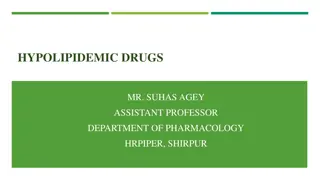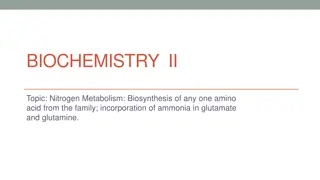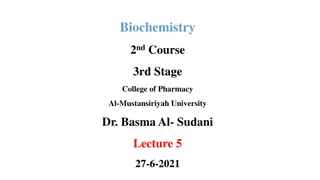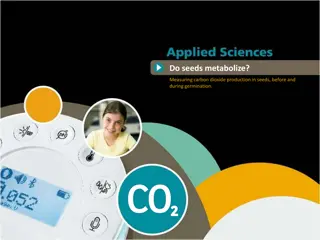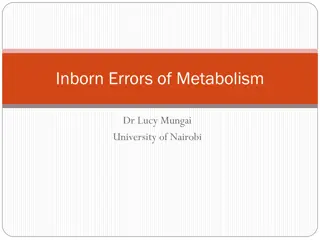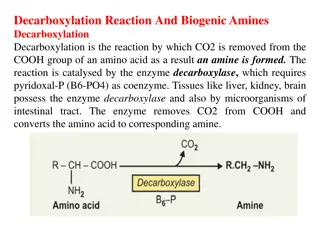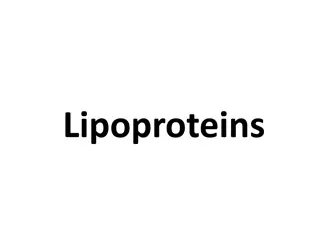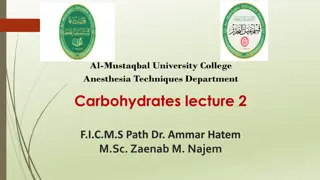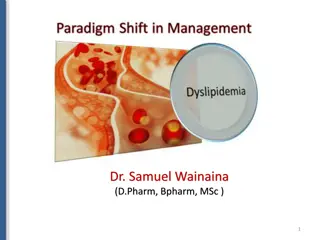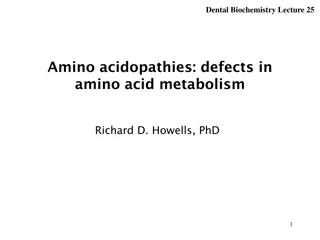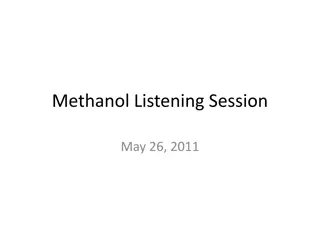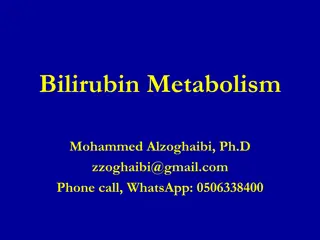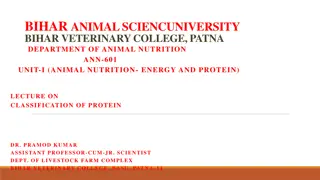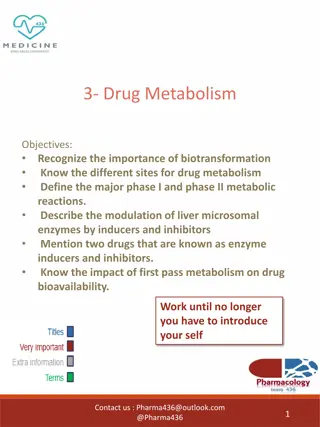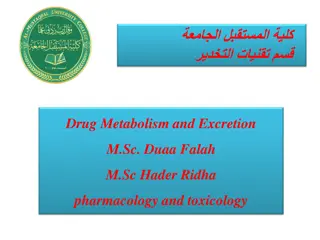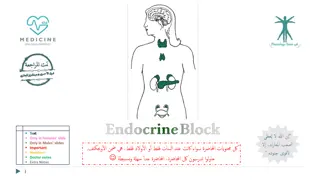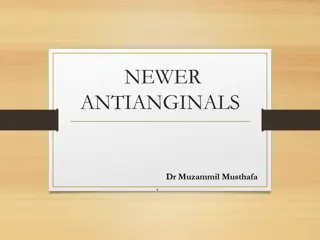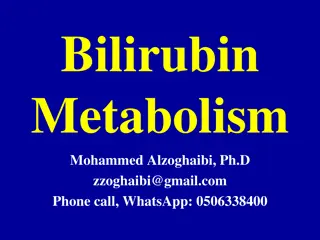
Lipoprotein Metabolism: Structure, Types, and Clinical Relevance
Explore the intricate world of lipoprotein metabolism, covering the structure, types, and related clinical issues such as atherosclerosis and fatty liver. Learn about the diverse functions of lipoproteins in lipid and protein transport within the body.
Download Presentation

Please find below an Image/Link to download the presentation.
The content on the website is provided AS IS for your information and personal use only. It may not be sold, licensed, or shared on other websites without obtaining consent from the author. If you encounter any issues during the download, it is possible that the publisher has removed the file from their server.
You are allowed to download the files provided on this website for personal or commercial use, subject to the condition that they are used lawfully. All files are the property of their respective owners.
The content on the website is provided AS IS for your information and personal use only. It may not be sold, licensed, or shared on other websites without obtaining consent from the author.
E N D
Presentation Transcript
Lipoprotein Lipoprotein Metabolism Metabolism By Reem Reem M. M. Sallam, Sallam,M.D., M.D.,MSc., MSc., Ph.D. Ph.D.
Introduction Introduction Lipid compounds: Relatively waterinsoluble Therefore, they are transported in plasma (aqueous) as Lipoproteins
Lipoproteins and Related Clinical Problems Atherosclerosis and hypertension Coronary heart diseases Lipoproteinemias (hypo- and hyper-) Fatty liver
Lipoprotein LipoproteinStructure Structure Protein part: Apoproteins orapolipoproteins Abbreviations: Apo-A, B, C, D,E Functions: Structural and transport function Enzymatic function Ligands forreceptors Lipid part: According to the type of lipoproteins Different lipid components in various combinations
Spherical molecules of lipids and proteins (apoproteins) Outercoat: -Apoproteins - Phospholipids - Cholesterol (Unesterified) Innercore: - TG - Cholesterol ester(CE) Lipoprotein LipoproteinStructure Structure
Types ofLipoproteins What s different in various types of lipoproteins? They differ in lipid and protein composition and therefore, they differ in - Size and density - Electrophoretic mobility
Chylomicrons Very low density Lipoprotein (VLDL) Types Types and Composition Composition of of Lipoproteins Lipoproteins and Low density Lipoprotein (LDL) High density Lipoprotein (HDL)
Ultracentrifugation Ultracentrifugation of of Lipoproteins Lipoproteins
Lipoprotein LipoproteinElectrophoresis Electrophoresis
Plasma PlasmaLipoproteins Lipoproteins For triacylglycerol transport (TG-rich): - Chylomicrons: TG of dietary origin - VLDL: TG of endogenous (hepatic) synthesis For cholesterol transport(cholesterol-rich): LDL: Mainly free cholesterol HDL: Mainly esterified cholesterol
Chylomicrons Assembled in intestinal mucosal cells Lowest density Largest size Highest % of lipids and lowest % proteins Highest triacylglycerol (dietary origin) Carry dietary lipids to peripheral tissues Responsible for physiological milky appearance of plasma (up to 2 hours after meal)
Very Low DensityLipoproteins VLDLs Assembled in liver High triacylglycerol (hepatic origin) Carry lipids from liver to peripheral tissues Nascent VLDL: contains Apo B-100 Mature VLDL: Apo B-100 plus Apo C-II and Apo E (from HDL)
Metabolism ofVLDLs Assembled and secreted by liver Mature VLDLs in blood Modifications of circulating VLDLs End products: IDL and LDL Related diseases: Hypolipoproteinemia:Abetalipoproteinemia Hyperlipoproteinemias: Type I hyperlipoproteinemia Familial type III hyperlipoproteinemia
VLDL VLDLMetabolism Metabolism
Metabolism of VLDLs: MatureVLDLs Assembled and secreted by liver directly into blood as nascent form Mature VLDLs: contain Apo B-100 plusApo C-II and Apo E. ApoC-II is required for activation of lipoprotein lipase Lipoprotein lipase is required to degrade TG into glycerol and fatty acids
Lipoproteinlipase Extracellular enzyme, anchored by heparan sulfate to the capillary walls of most tissues Predominantly present in adipose tissue, cardiac & skeletal muscle Requires ApoC-II for activation Degrades TG into glycerol and free fatty acids Insulin stimulates its synthesis and transfer to the luminal surface of the capillary If deficient (or if apo C-II is deficient) hyperlipoproteinemia = familial lipoproteinlipase deficiency) type 1
Modifications of CirculatingVLDLs 1 Degradation of TG by lipoprotein lipase VLDLs become Smaller in size More dense 2 Apo C & Apo E return back to HDL 3 Some TG are transferred from VLDL to HDLin exchange with cholesterol ester (By cholesterol ester transfer protein) VLDL IDL (returns Apo E to HDL) , LDL
Lipid Lipid- -Transfer TransferProtein Protein
VLDLs VLDLs- -Related RelatedDiseases 1- Hypolipoproteinemia Abetalipoproteinemia Defect in TG-transferprotein Apo B-100 cannot be loaded with lipid Accumulation of TG in liver 2- Fatty Liver (hepatic steatosis) Imbalance between hepatic synthesis ofTG and secretion of VLDLs. Accumulation of TG in liver Diseases
VLDLs VLDLs- -Related Diseases, Related Diseases, continued 3- Hyperlipoproteinemia Type I Hyperlipoproteinemia Familial Lipoprotein lipasedeficiency Due to deficiency of lipoprotein lipase or itscofactor (Apo C-II) Shows a dramatic accumulation ( 1000 mg/dl) of chylomicrons in plasma Usually associated with acute abdomen due to acute pancreatitis plasma TG even in the fastedstate Type III Hyperlipoproteinemia -Associated with hypercholesterolemia & premature atherosclerosis - (Familial dysbetalipoproteinemia) - due to Apo Edeficiency

